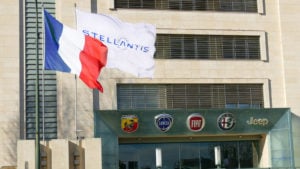Today we will discuss three car stocks to buy as the North American International Auto Show returns to Detroit after a three-year absence. Although it was a smaller event than in previous years, Wall Street was eager to see which automakers were driving in the fast lane.
In 2021, car sales metrics in the U.S. were strong. U.S. car sales approached 15 million, coming behind China with about 21.5 million. That said, automakers have dealt with several challenges so far this year.
For starters, the semiconductor shortage coupled with rising commodity and shipping costs have weighed on company operations and earnings. At the same time, new auto sales have hit the brakes, as consumers struggle amid fears about persistent inflation and a recession. According to the National Automobile Dealers Association, new car sales in the second quarter of 2022 are down more than 25% compared to the year before.
Nevertheless, it’s not all doom and gloom in the automotive industry. Luxury cars and high-margin SUVs gained market share over cars in the first half of 2022, while electric vehicle (EV) sales rose 66% in the second quarter year over year.
Recently, Congress passed the Inflation Reduction Act (IRA), a more than $430 billion spending package focused on energy transition and carbon reduction. The Act, which also includes investment tax credits for electrification, is expected to accelerate EV adoption in the U.S. Meanwhile, with the average age of cars on U.S. roads at record levels, consumers are expected to gradually start purchasing new vehicles, translating into higher revenues for car makers.
That said, here are three car stocks that are well-positioned to thrive in the months ahead.
| RACE | Ferrari | $190.09 |
| HAIL | SPDR S&P Kenosha Smart Mobility ETF | $33.50 |
| STLA | Stellantis | $12.81 |
Ferrari (RACE)

52-week range: $167.45 – $278.78
Italy-based Ferrari (NYSE:RACE) is well known for its luxury sports cars, and its also often associated with the Formula 1 racing team. That said, the company generates well over half of its revenue stateside.
Ferrari released Q2 robust financials in early August, demonstrating its resilience against the recent economic turbulence. In addition to record revenues of 1.3 billion euros, earnings also increased double digits from the previous year.
Thanks to its cash-rich customers, the iconic carmaker shipped 3,455 units in the quarter. Wall Street was pleased to see management raise full-year guidance on all metrics.
As part of its strategic plan, Ferrari is expanding into new segments, such as SUVs. Meanwhile, it is gearing up to unveil its first EV supercar in 2025. The company aims to have 15 new launches and 60% of its line-up electrified by 2026.
RACE stock has declined more than 23% year-to-date (YTD). Shares are trading at 32.36 times forward earnings and 7.72 times sales. Analysts’ 12-month median price forecast for Ferrari stands at $243.50. Potential investors could regard a decline toward the $180 level as a better entry point.
SPDR S&P Kensho Smart Mobility ETF (HAIL)

52-week range: $33.32 – 64.23
Dividend yield: 1.41%
Expense ratio: 0.45%, or $45 on an initial $10,000 investment
Our next discussion focuses on an exchange-traded fund (ETF) that may appeal to potential investors in the smart transportation industry. The SPDR S&P Kensho Smart Mobility ETF (NYSEARCA:HAIL) offers exposure to U.S.-listed car stocks that typically focus on autonomous and connected vehicle technology, drone technology, as well as advanced transportation tracking systems.
HAIL started trading in December 2017. This ETF follows the S&P Kensho Smart Transportation Index and currently has 93 holdings.
In terms of sub-segments, automobile manufacturers lead with 22.20%. Next are auto parts & equipment (12.5%) and semiconductors (11.4%). The top 10 holdings comprise around 18% of $77.4 billion in net assets.
Hydrogen fuel-cell systems manufacturer Plug Power (NASDAQ:PLUG); EV manufacturer Rivian Automotive (NASDAQ:RIVN); Israel-based sensor and vision software supplier Innoviz Technologies (NASDAQ:INVZ); EV charging equipment provider Blink Charging (NASDAQ:BLNK); and EV heavyweight Tesla (NASDAQ:TSLA) are among the most prominent names on the roster.
HAIL has declined over 34% since January, and currently yields a dividend of 2.31%. Trailing price-to-earnings (P/E) and price-to-book (P/B) ratios stand at 10.64x and 1.90x, respectively.
According to Precedence Research, the global smart mobility market is expected to hit $250 billion by 2030. Such an expansion would mean a compound annual growth rate (CAGR) of over 20% between 2022 and 2030. Thus, investors looking to benefit from the long-term secular growth in the smart transportation industry can consider investing in HAIL around these levels.
Stellantis (STLA)

52-week range: $11.37 – $21.92
The Netherlands-based Stellantis (NYSE:STLA) was formed in January 2021 as a result of the merger between Fiat Chrysler Automobiles and PSA Group. Through its global network, Stellantis offers a wide product range with 14 automobile brands, such as Alfa Romeo, Chrysler, Fiat, Jeep, Peugeot, Citroen, and Opel.
The recent earnings report showed a strong first-half-year (HY1) performance. Net revenue increased 17% YOY while profits also soared. Thanks to the company’s robust cash position, Stellantis can focus on expanding operations further with an emphasis on electrification.
According to HY1 figures, Stellantis ranked second in battery electric vehicle (BEV) and low emission vehicle (“LEV”) sales in the EU30 market, which includes 30 European countries. It also came in third in the U.S. for LEV sales.
In its Dare Forward 2030 plan, Stellantis set a goal of having BEVs account for 100% of its sales in Europe and 50% in the U.S. by 2030. Meanwhile, the carmaker is investing in battery technology in cooperation with LG Energy Solutions in Canada and Samsung SDI in the U.S.
So far this year, STLA stock is down over 27%. Its current price supports a dividend of 8%. Shares are changing hands at 2.86 times forward earnings and 0.26 times sales. Finally, the 12-month median price forecast stands at $20.59. Interested readers could consider buying the dips in Stellantis over other car stocks.
On the date of publication, Tezcan Gecgil, Ph.D., did not have (either directly or indirectly) any positions in the securities mentioned in this article. The opinions expressed in this article are those of the writer, subject to the InvestorPlace.com Publishing Guidelines.
